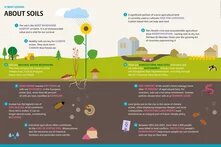Soil is the foundation of life on Earth. Its beauty and complexity as a living ecosystem are vast, and its functions are integral to our lives. For example, 95 percent of global food production depends on healthy soils, making access to fertile soil essential in the fight against hunger. Soils are also a crucial ally in adapting to climate change, as they help buffer the effects of droughts and floods.

Yet, climate change and competing global demands on soils place immense pressure on this invaluable resource, leading to soil erosion, biodiversity loss, and degradation. Indeed, a staggering one-third of the world’s soils are degraded. Meanwhile, land demands have yet again skyrocketed, inciting land grabs and human rights violations. Within Europe, this increasing land demand makes it difficult for young farmers to find affordable land.
In the face of waning political will to protect this precious asset – even as climate change impacts increase and land use competition intensifies – our Soil Atlas is much more than an act of defiance. It offers a critical scrutiny of the diverse challenges we face in nurturing the very foundation that sustains us: the ground beneath our feet. It also showcases practical solutions. For example, how farmers in the Sahel turned barren land into productive landscapes, and how agroforestry systems, by integrating trees and hedges into crop cultivation, can enhance biodiversity, soil health, water storage capacities, and carbon sequestration simultaneously.
The Soil Atlas 2024 also highlights key areas where collaborations and new alliances can be established to protect our soils. It also proposes a bottom-up approach to implementing joint actions and advocates for better natural resource governance, grounded in robust protection of human rights and land rights, particularly for women and local communities at heightened risk.
In the current political climate, global agreements on biodiversity, climate change, and the fight against desertification are under local pressure from political forces and often from economic interest groups. It is vital, however, that we insist on fulfilling multilateral commitments to push for policy change at both the European and international levels.
In 2006, the European Union (EU) introduced an ambitious Soil Framework Directive that aimed at harmonising soil protection strategies across EU Member States. However, in 2014, it was withdrawn due to strong opposition by Austria, France, Germany, the Netherlands, and United Kingdom.
This came at a price. Ten years later, the state of Europe’s soils remains dire. About 60 percent of soils are classified as damaged. Between 2012 and 2018, EU Member States lost around 450 square kilometres of soil per year to settlements and infrastructure. These developments threaten the continued provision of soil ecosystem services and thereby the very basis of the food we eat and the water we drink.
Yet, this year, instead of a comprehensive directive that aims to achieve 100 percent healthy soils in Europe by 2050, agreement was reached only to adopt a new Soil Monitoring Law that outlines a set of principles for sustainable soil management and aims to make soil health monitoring obligatory. While a modest step in the right direction, its targets are not legally binding, and the law misses opportunities to ensure integrated soil management. Moreover, the European Climate Law foresees the sequestration of 310 million tonnes of carbon through improved or changed land use. This requires protecting and rewetting peatlands in the EU, and a comprehensive directive could have made that clear.
Thirteen EU Member States are already affected by desertification. Yet, the European Court of Auditors has concluded that the steps taken by states to fight desertification lack coherence, and there is neither specific EU legislation addressing desertification, nor any integrated legislation on soil.
Globally, the demand for food, housing and infrastructure will increase as the population grows, with urbanisation and agriculture driving more land consumption, thereby increasing pressures on fertile soils. Climate action and environmental measures also make a claim on land. At the Montreal-Kunming Conference on Biodiversity in 2022, 196 countries committed to placing 30 percent of the global land area under protection to halt and reverse biodiversity loss. This remarkable commitment entails more land demands, as many national policies rely on land-based carbon sequestration in natural ecosystems. In fact, estimates suggest that more than one billion hectares of land are needed to meet these targets. These trends underscore the urgent need for better governance of soils and land resources.
In this way, while the Soil Atlas 2024 reveals the hidden and often underrated living layers beneath us, it also forewarns of the cost of inaction to the environment – and to our very life on Earth.
Preventing further soil degradation and restoring degraded soils is far more cost-effective than to deal with the severe consequences of soil loss. Yet, this perspective rarely takes centre stage in societal and political debates.
With the Soil Atlas 2024, we aim to change that. We welcome your engagement and collaboration to protect our soils and safeguard a just and sustainable future for all.

